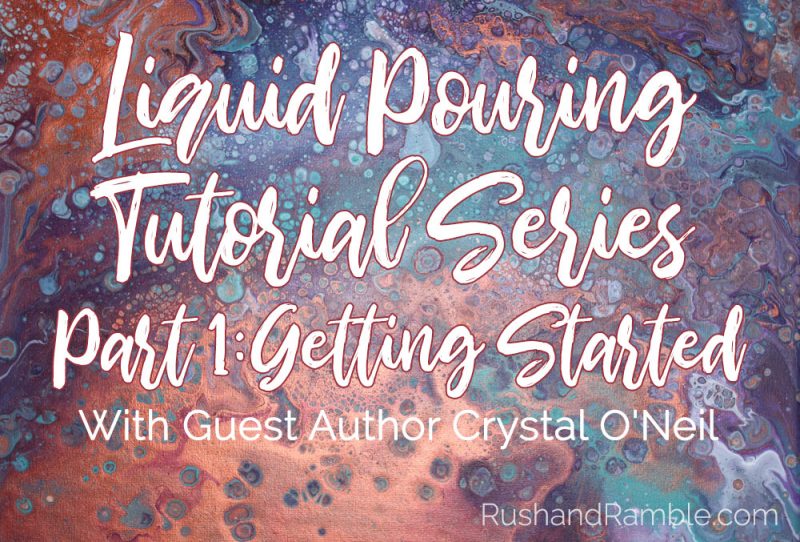Liquid Pouring Tutorial Series Part 1: Getting Started

I’ve had many questions and a lot of great feedback on my post about Dirty Pour acrylic painting. While I have quite a bit of experience with acrylic paint and I’ve played with the dirty pour technique quite a bit in the last year or so, I’m definitely not a subject matter expert. So I’ve invited my friend Crystal to join us and share her experiences and expertise.
Crystal is a certified Grumbacher Art Instructor and teaches painting classes regularly. She teaches a variety of styles and techniques and has graciously agreed to share some of her lessons here. No surprise, she had a LOT of great ideas and insights. I decided to break her lesson up into a 3 part mini series. Part 1 is going to introduce us to Crystal and her user-friendly techniques for achieving beautiful liquid pours. Be sure to check back over the coming weeks for Parts 2 and 3 where Crystal walks us through some pouring tips and fun techniques.
Liquid Pouring Tutorial Part 1: Getting Started
Liquid pouring~ the hot trend you have seen on Youtube, Facebook, IG… everywhere! The first time I saw a video I immediately thought, I can do that! A dozen canvases later I went to my manager to see if I could offer it as a class- I teach painting lessons at Michael’s Craft Stores. I set up a practice class with my managers and fleshed out what materials I need and how to create a syllabus to efficiently walk students through the project. That was over a year and half ago. In that time, I have tried numerous products and mastered a recipe that works and tried numerous techniques to create dramatic canvases. Roll up your sleeves and put a smock on- you will get messy!
Starting Small
The first canvases I did were small, 6×6”- I was afraid of the mess I might create in my tiny apartment. So much so, I did it in my galley kitchen, convinced it would be easier to wipe up the wood floor instead of carpet. Originally, I used craft paints, rubbing alcohol and glue along with silicone spray. I quickly realized that paint quality makes a huge difference.
Craft paints peel, and clump- while the texture is interesting, the paint is degraded by the process. I switched over to the fine arts acrylics and remedied the problems.
I worked with the 91% Isopropyl Alcohol in the very beginning- I had some on hand, after months of classes I switched to Liquitex Flow Aid. It is a concentrate you mix one 4oz bottle to 20 parts water (10 cups). I found the alcohol was harsher on your lungs, especially mixed with silicone and would catch fire when using the torch. Yes- I lit a few canvases on fire. It was terrifying and hilarious all in a few seconds!
Mastering the Basics
I am cheap, so my medium or bonding agent to mix with the paints is a white glue mixture. 3 part glue to 1 part water = medium. I use this mixture to help bond all the ingredients together and not degrade the paints. The recipe I use is 2 parts paint to one part glue mix (medium), then slowly add the flow aid until the paint run off your stirrer without clumping.
If you make it too thin it can create what I call dead spots on the canvas- the paint thins and doesn’t cover the canvas- just lightly tints color. This effect is irregular- so you will have a canvas covered in paint and circles or edges will bare. If your mixture looks watery- you can add more paint and/or glue. Consistency is key and there is no perfect measurement because each color, each brand of paint has different densities. You will find metallic paints need more liquid to thin it down. While other colors will need very little flow aid to achieve the desired consistency.
This truly is a learning process- the more you practice the more consistent you will be in mixing paints. My tip to you- if you are doing this often, get containers to store left over paints. I have seen people use water bottles. I have large paint containers with a screw top lid- I reuses over and over. I also use condiment squirt bottles.
Mixing your colors is the most time consuming process- have multiple canvases ready to paint, because you can quickly do several canvases once your paints are mixed.
Simple Dirty Pour with Silicone
I prefer a dirty cup method. This is where you stack multiple colors of paints into one cup- I use a silicone spray (found in the auto section of Walmart) to create a barrier between layers. This keeps the paints from mixing and muddying. I lightly spray silicone into the bottom of the cup first, then layer colors with a light shot between every layer and top it off with one more hit.
The silicone also creates cells- little circles where the paint underneath bubbles up to the surface creating irregular shapes. I usually stack my paints darkest to lightest- white and/or light colors seem to bubble to the surface better creating a dynamic look.
Once you have a cup of paints- you can flip it onto the canvas. I let mine drain for about a minute- remove the cup and tilt corner to corner and then opposite corners- letting the paint run over the edges. If you see colors you want to keep on the canvas- be mindful when tilting.
Also, be aware there is a “developing” process. What you see when you first finish will morph as the paints bubble up to the surface. Cells will pop up, the paint will still move a bit. Generally the developing happens in the first hour, though these canvases take 18 to 24 hours to fully dry.
Go Create
There you have it. Did you enjoy your first lesson with Crystal? Be sure to come back next week for Part 2. In the meantime, go make something beautiful and be sure. When you are done, visit Crystal O’Neil Painting and Rush and Ramble on Facebook and share a picture of your work of art.
Want more hands on instruction? Check out Crystal O’Neil Painting for information on upcoming classes in Jacksonville, Florida.
More in This Series
Liquid Pouring Tutorial Series Part 2: Tips for Acrylic Liquid Pour


